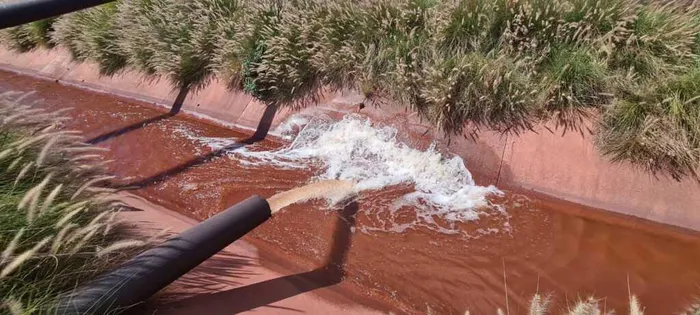South Africa to launch R15 billion infrastructure bond to boost project investment levels
MTBPS

Finance Minister Enoch Godongwana said the Water Partnerships Office is making progress in preparing non-revenue water and reuse projects across municipalities. These aim to create a pipeline for the private sector to co-invest in.
Image: Supplied
The government will launch a R15 billion infrastructure bond soon to help fund badly needed infrastructure projects, which, in turn, should provide a stimulus for faster economic growth and job creation in the economy.
Finance Minister Enoch Godongwana said in the MTBPS that the government will also contribute R2bn to capitalise a Credit Guarantee Vehicle. Initially, this vehicle will support electricity transmission expansion - South Africa’s renewable energy rollout is being stymied by a shortage of thousands of kilometres of transmission lines, such as between the Northern Cape, where many new renewable energy operations are based, and other parts of the country.
“This heralds a new era in PPPs (Public-Private Partnerships), where private investment in high-voltage transmission lines is enabled,” he said.
South Africa has, for at least two decades, suffered from declining infrastructure investment. Capital investment has been flat overall in the past two years because slowly rising public sector investment has offset falling private sector investment. President Cyril Ramaphosa has consistently described infrastructure development as the flywheel required to get the economy to grow faster.
“We are shifting the composition of spending from consumption to investment. Capital payments are the fastest-growing expenditure item at 7.5 per cent over the medium term,” said Godongwana.
He said amendments to PPP regulations took effect on June 1, 2025, and these were expected to unlock the potential across spheres of government, and streamline approvals for smaller projects.
The Budget Facility for Infrastructure (BFI) will now also run four bid windows annually, rather than just one.
Since the reconfiguration, the BFI has received 28 submissions, and nine projects were accepted for detailed analysis, said Godongwana.
In addition, R4.1bn had been allocated for disaster relief to fix schools, pipelines, clinics, and substations damaged between last year and this year by flooding in KwaZulu Natal, Mpumalanga, and the Eastern Cape.
Three weeks ago, new guidelines on unsolicited bids and fiscal commitments and contingent liabilities were issued, which took effect immediately.
The unsolicited bid guideline provides a pathway for the private sector to submit project ideas to the government. It also provides a framework for reporting and managing PPP projects.
Municipal PPP regulations will be amended by 2026, he said.
The Department of Transport's private-sector participation unit, following strong interest from freight logistics requests for information, will issue the first rail corridor request for proposal by December 2025, with others following in early 2026.
The unit has also issued requests for information for investment opportunities in modernising and growing the passenger rail system.
The Water Partnerships Office is making progress in preparing non-revenue water and reuse projects across municipalities. These aim to create a pipeline for the private sector to co-invest.
A new Infrastructure Finance and Implementation Support Agency will be operational by March 2026. The agency will provide project preparation support to supply the BFI pipeline.
The government is also piloting a utility reform programme to stabilise and professionalise water and electricity businesses in a few municipalities in Mpumalanga.
“We will use accredited indirect delivery partners such as the DBSA and MISA to provide the infrastructure while building municipal capability to do this on their own. This is how we will ensure our goal of public sector investment in infrastructure exceeds the R1 trillion mark over the next three years,” said Ramakgopa.
Standard Bank Head of South Africa Macroeconomic Research Elna Moolman said the funding for infrastructure spending was increased as expected, and there were additional allocations for spending items ranging from disaster rehabilitation to the Border Management Authority, the Office of the Chief Justice, Stats SA, and Transnet infrastructure rehabilitation programmes.
“These increases were counteracted by savings from the lower inflation trajectory, underspending, savings from the new Targeted and Responsible Savings (TARS) programme, and interest savings,” she said.
Bongani Motsa, acting chief economist of the Minerals Council of South Africa, said: “A lot of investment is needed in the electricity and logistics sectors to support an improved fiscal outlook. It is not obvious where that money will come from apart from outside of government. Until we see investment levels pick up and start improving the rail and electricity networks, we remain cautiously optimistic.”
Lula, a banking platform principally for small and medium-sized businesses, praised the measurable progress in infrastructure indicated in the MTBPSA, such as the confirmation that reforms are gaining speed, with the first rail corridor Request for Proposal due by December 2025, and port vessel waiting times down by 75%.
“Minister Godongwana has delivered a strong signal of intent on fiscal management and infrastructure, the two pillars of SME operating risk,” said Rossiter.
BUSINESS REPORT